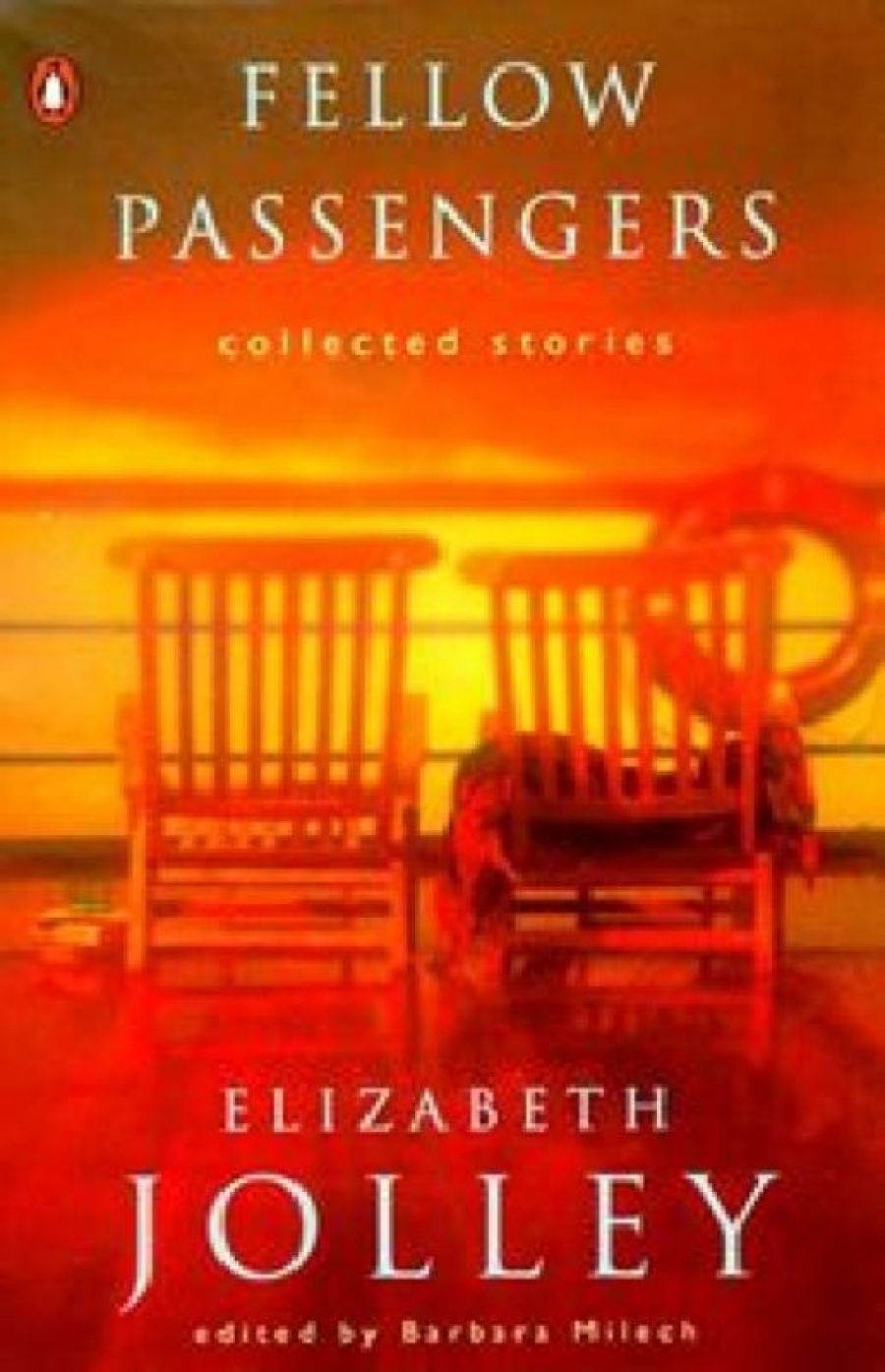
- Free Article: No
- Contents Category: Short Stories
- Review Article: Yes
- Online Only: No
- Custom Highlight Text:
Elizabeth Jolley is quoted in this volume saying that ‘Writing for me is a ragged and restless activity with scattered fragments to be pieced together rather like a patchwork quilt.’ To a degree this is an apt metaphor, suggesting as it does careful attention to the particular and the gradual accumulation of the discrete parts into a whole. It also suggests the contrast between light and dark that is the feature of many quilts and of Jolley’s writing. However, patchwork is altogether too domestic an activity to contain the driving intelligence and iconoclasm that are dominant elements in Jolley’ s work.
- Book 1 Title: Fellow Passengers
- Book 1 Subtitle: Collected stories
- Book 1 Biblio: Penguin, $16.95 pb, 371 pp
Fellow Passengers comprises twenty-one stories, thirteen of which have previously been published in the collections Five Acre Virgin (FACP, 1976), The Travelling Entertainer (FACP, 1979) and Woman in a Lampshade (Penguin, 1983). There are eight previously uncollected stories, all of which have been published independently in various anthologies or newspapers.
The editor, Barbara Milech, has chosen stories intended to reflect the fruits of Jolley’s thirty-year publishing period, demonstrating her tonal range and technical development, and to reflect on the filiations in Jolley’s writing between human desire, silence and writing.
Because Milech has limited herself in the first two sections of the book to stories published in collections, some of Jolley’s earliest stories – those such as ‘A Hedge of Rosemary’ published in 1967 – have not been included. Thus the actual publication dates of the stories in Fellow Passengers cover only a twenty-year period, although these stories do of course ‘reflect’ on the entire body of work. I wonder if an omnibus edition might not have been possible? Notwithstanding, Fellow Passengers works well as a single collection, providing in a single volume most of Jolley’s major short fiction.
The first two stories (‘Five Acre Virgin’ and ‘A Gentleman’s Agreement’) introduce Jolley’s preoccupation with the land, as a yearned-for place, or, in counterpoint, as the spoiler of dreams. Also introduced are themes and styles of writing that recur in Jolley’s stories and novels: the mischievous older woman; the submissive daughter; the spoilt son; the prevalence of fantasy; the longing to nurture or love; the interest in people who have been marginalised in society. These stories also demonstrate Jolley’s quirky sense of humour and her ability to flip from humour to pathos or despair and back again, the two inextricably entwined. There is a surprising lack of physical definition of the characters, which is true even in the later stories in which character plays a more important part.
The fourth story, ‘The Shepherd on the Roof’, is much more technically experimental, giving a taste of the greater complexity of the later stories. It is hypnotically repetitive, like the road the narrator travels, and slides forward and backward in time.
‘The Fellow Passenger’ is representative of Jolley’s bleak, introspective stories. The narrator, a surgeon, allows Jolley to explore the destructive side of the need to nurture. The surgeon’s desperate need is portrayed as an illness, which manifests itself in fastidiousness, misogyny and homosexuality. In variant forms these themes recur in Jolley’s stories and novels, although her expression of them, and her stance, shifts substantially. The joy of reading a compendium such as this is that it reveals the extraordinary complexity and subtlety of Jolley’s view of the world, and the generosity of her spirit.
The extension of ‘The Fellow Passenger’ to the plural to provide the title encourages analysis of travel in Jolley’s work. As with all other themes, there is no simple, reductive stance evident. Travel is a disturbance for people who yearn for the comfort of the home or land. It is a time when people are confronted by their need, their loneliness or their weakness. For some (‘Paper Children’, ‘The Fellmonger’) it is something to be resisted. For others it has an illicit attraction. (The main character, in ‘An Intellectual Father’, ‘recalls with quiet excitement ... that the path leads on into the wild edges of the bush.’) In ‘Three Miles to an Inch’ it is a lifetime travelled, a small thing and an immense thing simultaneously, the linking and fracturing of the generations and of opposite ends of the world.
It is not possible in a brief review to explore all of the fascinating themes and facets of Jolley’ s writing as presented in this reasonably comprehensive collection of stories. There are theses written, and there will be many more, on the occurrence and recurrence of characters and stories in her work, on her use of humour, on a Freudian perspective and on music and religious references, to name but a few. The editor’s desire to explore the relationship between writing and desire is perhaps a bit ambitious in this form. She has provided source material and some of the author’s reflections, but the teasing out is better done by her or others in more extended criticism.
Of all the pleasurable discoveries I made reading this collection, perhaps the most poignant is the recurrence of the fabled ‘honey tree’, which is a symbol of romantic yearning for a Garden of Eden in three of these stories. Jolley’s literary contribution is a honey tree, complete with bees that sting.


Comments powered by CComment